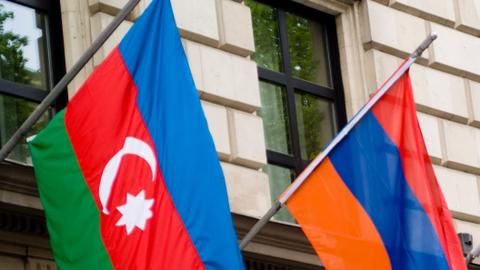~"We have to understand our history in order to not repeat the mistakes of the past. I have seen too many instances where people continue to pursue wrong courses of action because they do not take the time to think critically about what has happened in the past." - Winston Churchill.
~“We have to understand our history in order to not repeat the mistakes of the past. I have seen too many instances where people continue to pursue wrong courses of action because they do not take the time to think critically about what has happened in the past.” - Winston Churchill.
In April 1920, Kemal Atatürk, the founding father of modern Turkey, appealed to Vladimir Lenin with a proposal to develop a common military strategy in the Caucasus for protection against imperialist dangers. This was to be a "Caucasus Barrier" created by the Dashnaks, Georgian Mensheviks and the British as an obstacle between Turkey and Soviet Russia, writes Gary Cartwright.
After the defeat of the Ottoman Empire in World War I, Armenia, which appeared on the political map of the world at the expense of the Ottoman Empire (in the Caucasus, and on the territories of other states) did not lose its appetite for expansion.
The war continued with the newly formed Turkey and with the help of the USA and the Entente (the Russian Empire, the French Third Republic and Great Britain). On 10 August 1920, the Peace of Sèvres was signed, which formalised the division of Arab and European possessions of the Ottoman Empire. Although the members of the Entente had achieved most from the Treaty of Sèvres, Turkey lost Syria, Lebanon, Palestine, Mesopotamia and the Arabian Peninsula.
Armenia, which did not receive the promised lands, was left out: Antanta - the triple entente - had needed Armenia only as a temporary tool to weaken and force Turkey to peace.
On September 24th 1920, a state under the name Armenia was established on the lands of Azerbaijanis: during the ensuing conflict Armenia’s fledgling army was destroyed and the entire territory of the Dashnak government, except for Erivan and Lake Gokca (now Sevan), came under Turkish control.
On 15th November 1920, the Government of Armenia requested the Grand National Assembly of Turkey (GNA) to start the peace negotiations.
On 3rd December 1920 in the city of Gyumri (Alexandropol) a peace treaty was signed between Armenia and Turkey, according to which the territory of the Republic of Armenia was limited to the region of Erivan and Lake Gokcha. Armenia was obliged to abolish compulsory conscription and have an army of up to 1500 bayonets and 20 machine guns. Turkey acquired the right to freely transit and conduct military operations on the territory of this state. Armenia also pledged to withdraw all its diplomatic delegations.
Thus the first Republic of Armenia ended in ignominy. As a result of the capitulation, the Armenian government transferred its authority to the Soviet Union. The dream of a "Greater Armenia" remained just a dream.
But the Soviets did not intend to offend the Armenians, and they made them a gift of Zangezur (historical land of Azerbaijan) as well as autonomy over Karabakh within the Azerbaijani SSR. The decision was that Karabakh would remain autonomous within Azerbaijan, and was not given to Armenia as some Armenian historians now claim.
Thus Armenia owes its current internationally recognised borders to Lenin’s Soviet Union.
The Karabakh war that Armenia began with Azerbaijan in the 90s might be seen as a second phase of the "Armenian Dream". However, by 1994 Armenia controlled only 14% of Nagorno-Karabakh, having been out-fought by the Azerbaijani army all the way.
In the current conflict, which erupted on the morning of September 27th with Armenian artillery barrages, history does indeed appear to be repeating itself, with Azerbaijani forces recovering lost territory as early as the first day of fighting.
This presents Russia with a dilemma: to fuel the Armenian dream with give free weapons and to and ruin relations with its neighbours on the southern borders, or to provoke Azerbaijan into a major conflict, drawing in Turkey and Pakistan?
If the first option threatens Russia with the continued loss of its multibillion-dollar military-industrial complex, the second option is the end of its presence in the South Caucasus region as a regional leader.
In addition to all the vain pressure from Russia, the need to create a new military bloc with the participation of Azerbaijan, Turkey, Iran, Iraq, Afghanistan, Pakistan and Ukraine, which will fully cover the strategic borders of Europe and Asia.
In today's geopolitical landscape, such a military bloc would very quickly find worthy patrons to effectively contain the growing threats from China and Russia.
And can Russia really afford to lose its sincere partner Azerbaijan, whose foreign policy has not gone beyond good neighbourly relations with Russia, despite all the known pressures from all sides over the years?
The alternative to this catastrophe is a new, much more balanced and therefore stable, predictable political and economic balance of power in the region based on just one consensus - the territorial integrity of Azerbaijan within its recognised borders with the complete liberation of all occupied territories.
Azerbaijan has been and will continue to be committed to honest and allied relations with its neighbours, and has not allowed or will not allow third countries to use its territory to harm neighbouring countries. This is primarily because Azerbaijan, unlike Armenia, is a sovereign state in the full sense of the word.
History repeats itself, conclusions are not being drawn, and this is frightening. To conclude with the same thesis as we started, inviting Armenians and Russians to draw conclusions and take the real state of affairs as a basis not for desire, but for reality.
The opinions expressed in the above article are those of the author, and do not reflect any opinions on the part of EU Reporter.





































